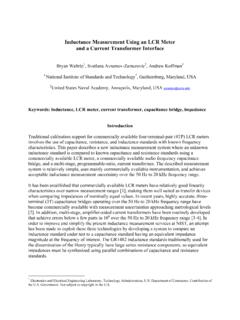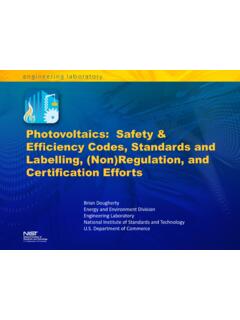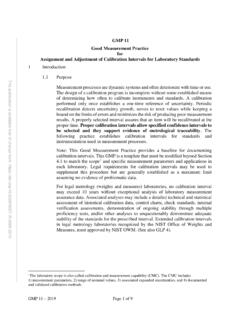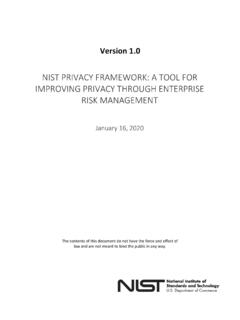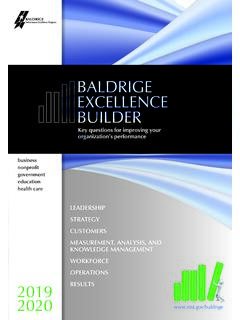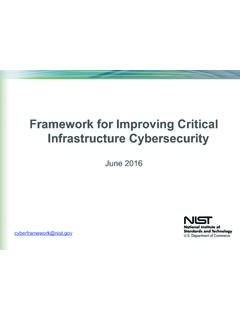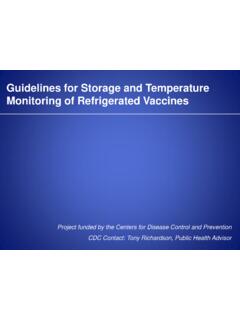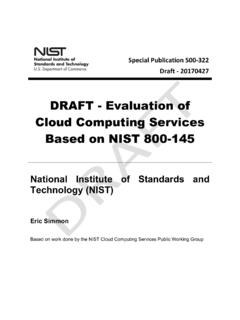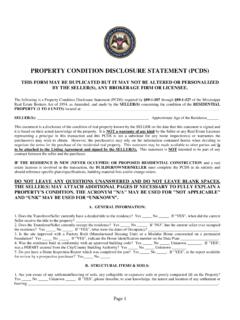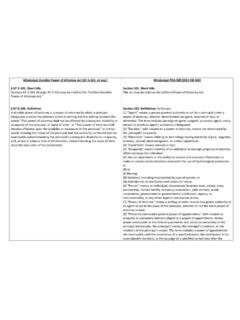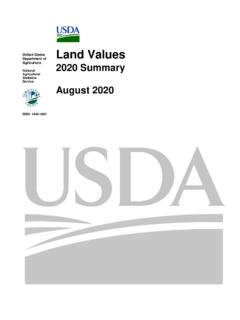Transcription of The Emerging U.S. Rail Industry: Opportunities to support ...
1 This paper examines the current state of the rail transit industry along with its manufacturing supply chain and provides recommendations about potential changes for policy makers and NIST MEP to consider. These recommendations are the opinions of the authors and are based upon the data and information collected and analyzed in the conduct of this study. The views expressed in the paper are those of the authors and do not necessarily represent the views or recommendations of the National Institute of Standards and Emerging Rail Industry: Opportunities to support American manufacturing and spur regional developmentThe Emerging Rail Industry1 Authors: Erik R. Pages, Brian Lombardozzi and Lindsey WoolseyErik R. Pages is President of EntreWorks Consulting, an economic development consulting firm based in Arlington, VA. He has supported numerous projects that link manufacturers to new regional economic development Opportunities , including recent projects for the North Carolina Rural Center, the Roanoke Blacksburg (VA) Innovation Blueprint, and for state economic development agencies in Maine, mississippi , and Lombardozzi is the principal of METPS, LLC and his work focuses on manufacturing, energy, and transportation policy strategies that specializes in federal, state, and local policy, making key connections between the business, labor, environmental and economic justice communities in working towards common policy Woolsey is the President of The Woolsey Group, LLC, a research and technical assistance firm that works with state and local leaders on industry cluster development and sector strategies that better connect education and training programs to the needs of regional labor markets.
2 She has worked with sector/cluster partnerships in manufacturing, energy, technology, bioscience, aerospace, agriculture, healthcare, tourism, and the creative to support American manufacturing and spur regional developmentExecutive SummaryA number of factors have come together to heighten the importance of rail transit to the U. S. economy. These same factors present new Opportunities for domestic manufacturers of rail cars and equipment to benefit, however, historical and structural barriers to seizing these Opportunities exist. In brief, the scenario can be described as follows:Rail ridership is strong and growing. Amtrak enjoyed its strongest year since its inception with ridership growing to million passengers in Fiscal Year 2012, a increase over the previous year, with July 2012 representing the single best month in Amtrak history. Overall ridership on commuter, light and heavy rail grew by 72% over the period from 1995 to 2008 and cities have added 29 new light rail and 20 new commuter rail systems in the last three decades.
3 Demand has led to new investment. In recent years Federal investments in rail passenger cars and locomotives have totaled several billion dollars. Efficiencies built into procurement policies for programs such as the High-Speed Intercity Passenger Rail initiative and implementation of the Next Generation Corridor Equipment Pool Committee hold promise for continuing Federal awards. There have been parallel investments at the state level, for example, California s investment of $8 billion to develop America s first high speed factors create Opportunities for rail manufacturing, but challenges exist. Consistent with provisions in the American Reinvestment and Recovery Act (ARRA), and previous legislation, these recent rail procurements contain Buy America provisions that require the use of goods manufactured in the United States. Currently, however, most rail equipment manufacturers are foreign-owned and limit activities to some final assembly work. Decades of limited business Opportunities in rail manufacturing have created significant gaps in both the capability and capacity of the domestic rail supply chain.
4 Innovation and intelligent investment can help capitalize on these Opportunities . Public agencies, as the primary buyers of new rail cars and equipment, can use their power as smart buyers to support demand driven innovation strategies. Looking to tap unutilized capacity in the existing manufacturing sector through supplier scouting efforts, investing in supply chain connectivity, and leveraging ongoing efforts to develop a more competitive manufacturing workforce can all aid the domestic rail industry s competitiveness. Examples from overseas present a variety of strategies that can accomplish these goals. Networking supply chains, such as the Supplier Scouting work of the Manufacturing Extension Partnership program, represents a promising practice. The Hollings Manufacturing Extension Partnership (MEP) program, housed at the National Institute of Standards and Technology, has utilized its network of 60 MEP centers around the country to develop business intelligence on rail transit supply chain needs.
5 These centers can rapidly reach out to their network of tens of thousands of small and mid-sized manufacturers to meet Emerging needs for domestic suppliers. A full description of the effort is included. Rail manufacturing has potential as a driver of regional economic development. By combining top-down policies with a bottom-up approaches to viewing rail manufacturing as an economic development strategy communities and regions could generate significant synergies. Investments in rail infrastructure reduce costs and pollution while increasing efficiency of transportation, access to goods, and career options. Helping local manufacturers capitalize on the business Opportunities represented by such investments would build on manufacturing s strong multiplier effect and ripple these benefits out into the region in the form of new jobs, more dynamic businesses, and a prosperous and diverse local economy. This paper explores each of these areas in detail and makes recommendations to policy makers on how they might best support a strong and growing domestic supply chain for the rail transit industry.
6 The Emerging Rail Industry3 After decades of negative headlines, American manufacturers are enjoying some positive news. Media stories herald the renaissance of American manufacturing, with think tanks, business consultants and communities devising strategies for the reshoring of American manufacturing jobs. Capitalizing on the potential for an American manufacturing renaissance requires a host of investments and policy reforms to help build a more competitive innovation ecosystem for American This shift also requires a forward looking mindset that seeks to identify Emerging market Opportunities for both existing and new American manufacturing firms. It is not enough to simply recapture markets or contracts lost to foreign competition. American manufacturers must also develop new capacities to capture new market Opportunities . The list of these potential new markets is sizable. The President s Council of Advisors on Science and Technology (PCAST ) has identified eleven Emerging growth sectors in fields such as additive manufacturing, nanomanufacturing, and industrial robots.
7 Critical investments in these Emerging sectors are essential, but Opportunities also exist in numerous existing industries and sectors. Rail transportation falls into this latter category, and has been identified by many leading experts as a sector with great growth potential for new jobs, new innovations, and new business Opportunities . For example, the Apollo Alliance s 2010 Transportation Manufacturing Action Plan projected that new investment programs in transit and inter-city passenger rail could create as many as 600,000 new manufacturing Communities across the US are hoping to capitalize on these Opportunities ---as a means to spur new manufacturing jobs and to address pressing transportation concerns. Over the past few years, regions across the have expressed growing interest in developing passenger rail as a core part of their local transportation systems and infrastructure. This growing interest stems from multiple factors, including frustration with traffic congestion, increasing demand for a wider variety of transportation choices, and concern about climate change.
8 In the late 2000s, these trends were accelerated by the Obama Administration s major investments in High Speed Rail (HSR) and other next generation rail and transit projects. While funding is not yet stable or certain, the basic market fundamentals that are driving the expansion of passenger rail remain in place. Advocates for expanded rail investment make a compelling social and economic case. They note that passenger rail projects help reduce congestion, ease the movement of goods and people, and help create other economic spin-offs. They note, but often fail to emphasize, that expanded rail infrastructure also offers tremendous Opportunities for American manufacturers. This rail renaissance offers an opportunity to rebuild the rail industry a global leader for much of the 20th century, but a neglected and declining sector since the 1970s. Rail manufacturing is a big employer today, providing jobs for roughly 90,000 workers. Yet, it is difficult to speak of a cohesive and organized rail manufacturing industry.
9 Most major original equipment manufacturers (OEMs) and leading suppliers are foreign-owned. They perform final assembly and conduct some manufacturing in the , but their high-value activities and most of their market focus is devoted to larger overseas markets. Meanwhile, because major rail procurements have been so rare, smaller For recent recommendations, see the President s Council of Advisors on Science and Technology, Report to the President on Capturing Domestic Competitive Advantage in Advanced Manufacturing, Washington, DC: Executive Office of the President, July Apollo Alliance, Make it in America: The Apollo Clean Transportation Manufacturing Action Plan, San Francisco: Apollo Alliance, rail projects require new locomotives and rail cars, new equipment, new orders of iron and steel and new infrastructure. Where possible, all of these innovative products, services, and technologies can and should be supplied by American manufacturers. These new market Opportunities can generate new economic development Opportunities in communities across the 4 Opportunities to support American manufacturing and spur regional developmentmanufacturers of key components such as castings, parts, and wiring have understandably focused on other markets such as aerospace and the automobile industry.
10 Given these dynamics, it is unlikely that a strong rail manufacturing industrial base will emerge on its own or through market-driven behaviors. Key federal, state and local agencies should act to spur the development of stronger supply chain connections and capacities. As the primary buyers of new rail cars and equipment, public sector agencies can use their power as smart buyers to support new demand-driven innovation strategies. They can invest in R&D and pro-actively build closer connections within the rail supply chain. These agencies can also leverage existing programs and investments to develop a more competitive manufacturing workforce. Efforts to develop new training tools and strengthen occupations that are core to manufacturing will aid the rail industry s competitiveness. As these efforts move forward, rail manufacturing can become a core focus of local economic development efforts. Investments in rail infrastructure are widely recognized as drivers of local economies.
